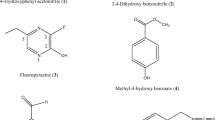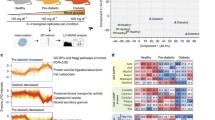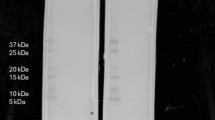Abstract
Monosodium glutamate-obese rats are glucose intolerant and insulin resistant. Their pancreatic islets secrete more insulin at increasing glucose concentrations, despite the possible imbalance in the autonomic nervous system of these rats. Here, we investigate the involvement of the cholinergic/protein kinase (PK)-C and PKA pathways in MSG β-cell function. Male newborn Wistar rats received a subcutaneous injection of MSG (4 g/kg body weight (BW)) or hyperosmotic saline solution during the first 5 days of life. At 90 days of life, plasma parameters, islet static insulin secretion and protein expression were analyzed. Monosodium glutamate rats presented lower body weight and decreased nasoanal length, but had higher body fat depots, glucose intolerance, hyperinsulinemia and hypertrigliceridemia. Their pancreatic islets secreted more insulin in the presence of increasing glucose concentrations with no modifications in the islet-protein content of the glucose-sensing proteins: the glucose transporter (GLUT)-2 and glycokinase. However, MSG islets presented a lower secretory capacity at 40 mM K+ (P < 0.05). The MSG group also released less insulin in response to 100 μM carbachol, 10 μM forskolin and 1 mM 3-isobutyl-1-methyl-xantine (P < 0.05, P < 0.0001 and P < 0.01). These effects may be associated with a the decrease of 46 % in the acetylcholine muscarinic type 3 (M3) receptor, and a reduction of 64 % in PKCα and 36 % in PKAα protein expressions in MSG islets. Our data suggest that MSG islets, whilst showing a compensatory increase in glucose-induced insulin release, demonstrate decreased islet M3/PKC and adenylate cyclase/PKA activation, possibly predisposing these prediabetic rodents to the early development of β-cell dysfunction.





Similar content being viewed by others
Explore related subjects
Discover the latest articles and news from researchers in related subjects, suggested using machine learning.References
Tengholm A, Gylfe E (2009) Oscillatory control of insulin secretion. Mol Cell Endocrinol 297(1–2):58–72
Cnop M, Welsh N, Jonas JC, Jorns A, Lenzen S, Eizirik DL (2005) Mechanisms of pancreatic beta-cell death in type 1 and type 2 diabetes: many differences, few similarities. Diabetes 54(Suppl 2):S97–S107
Ribeiro RA, Santos-Silva JC, Vettorazzi JF, Cotrim BB, Mobiolli DD, Boschero AC, Carneiro EM (2012) Taurine supplementation prevents morpho-physiological alterations in high-fat diet mice pancreatic beta-cells. Amino Acids 43(4):1791–1801
Ahren B (2000) Autonomic regulation of islet hormone secretion–implications for health and disease. Diabetologia 43(4):393–410
Olney JW, Sharpe LG (1969) Brain lesions in an infant rhesus monkey treated with monsodium glutamate. Science 166(3903):386–388
Maiter D, Underwood LE, Martin JB, Koenig JI (1991) Neonatal treatment with monosodium glutamate: effects of prolonged growth hormone (GH)-releasing hormone deficiency on pulsatile GH secretion and growth in female rats. Endocrinology 128(2):1100–1106
Martins AC, Souza KL, Shio MT, Mathias PC, Lelkes PI, Garcia RM (2004) Adrenal medullary function and expression of catecholamine-synthesizing enzymes in mice with hypothalamic obesity. Life Sci 74(26):3211–3222
Balbo SL, Grassiolli S, Ribeiro RA, Bonfleur ML, Gravena C, Brito Mdo N, Andreazzi AE, Mathias PC, Torrezan R (2007) Fat storage is partially dependent on vagal activity and insulin secretion of hypothalamic obese rat. Endocrine 31(2):142–148
Lucinei Balbo S, Gravena C, Bonfleur ML, de Freitas Mathias PC (2000) Insulin secretion and acetylcholinesterase activity in monosodium l-glutamate-induced obese mice. Horm Res 54(4):186–191
Balbo SL, Bonfleur ML, Carneiro EM, Amaral ME, Filiputti E, Mathias PC (2002) Parasympathetic activity changes insulin response to glucose and neurotransmitters. Diabetes Metab 28(6 Pt 2):13–17 discussion 13S108-112
Nardelli TR, Ribeiro RA, Balbo SL, Vanzela EC, Carneiro EM, Boschero AC, Bonfleur ML (2011) Taurine prevents fat deposition and ameliorates plasma lipid profile in monosodium glutamate-obese rats. Amino Acids 41(4):901–908
Paes AM, Carniatto SR, Francisco FA, Brito NA, Mathias PC (2006) Acetylcholinesterase activity changes on visceral organs of VMH lesion-induced obese rats. Int J Neurosci 116(11):1295–1302
Mitrani P, Srinivasan M, Dodds C, Patel MS (2007) Autonomic involvement in the permanent metabolic programming of hyperinsulinemia in the high-carbohydrate rat model. Am J Physiol Endocrinol Metab 292(5):E1364–E1377
Scomparin DX, Gomes RM, Grassiolli S, Rinaldi W, Martins AG, de Oliveira JC, Gravena C, de Freitas Mathias PC (2009) Autonomic activity and glycemic homeostasis are maintained by precocious and low intensity training exercises in MSG-programmed obese mice. Endocrine 36(3):510–517
Andreazzi AE, Scomparin DX, Mesquita FP, Balbo SL, Gravena C, De Oliveira JC, Rinaldi W, Garcia RM, Grassiolli S, Mathias PC (2009) Swimming exercise at weaning improves glycemic control and inhibits the onset of monosodium l-glutamate-obesity in mice. J Endocrinol 201(3):351–359
Bernardis LL, Patterson BD (1968) Correlation between ‘Lee index’ and carcass fat content in weanling and adult female rats with hypothalamic lesions. J Endocrinol 40(4):527–528
Ribeiro RA, Vanzela EC, Oliveira CA, Bonfleur ML, Boschero AC, Carneiro EM (2010) Taurine supplementation: involvement of cholinergic/phospholipase C and protein kinase A pathways in potentiation of insulin secretion and Ca2+ handling in mouse pancreatic islets. Br J Nutr 104(8):1148–1155
Harms PG, Ojeda SR (1974) A rapid and simple procedure for chronic cannulation of the rat jugular vein. J Appl Physiol 36(3):391–392
Bergmeyer HU, Bernt E (1974) Determination of glucose with glucose oxidase and peroxidase. In: Bergeyer HU (ed) Methods of enzymatic analysis. Verlag Chemie, Weinhein, pp 1105–1212
Bonora E, Targher G, Alberiche M, Bonadonna RC, Saggiani F, Zenere MB, Monauni T, Muggeo M (2000) Homeostasis model assessment closely mirrors the glucose clamp technique in the assessment of insulin sensitivity: studies in subjects with various degrees of glucose tolerance and insulin sensitivity. Diabetes Care 23(1):57–63
Matthews DR, Hosker JP, Rudenski AS, Naylor BA, Treacher DF, Turner RC (1985) Homeostasis model assessment: insulin resistance and beta-cell function from fasting plasma glucose and insulin concentrations in man. Diabetologia 28(7):412–419
Straub SG, Sharp GW (2002) Glucose-stimulated signaling pathways in biphasic insulin secretion. Diabetes Metab Res Rev 18(6):451–463
Grassiolli S, Bonfleur ML, Scomparin DX, de Freitas Mathias PC (2006) Pancreatic islets from hypothalamic obese rats maintain K+ ATP channel-dependent but not-independent pathways on glucose-induced insulin release process. Endocrine 30(2):191–196
Wu G, Morris SM Jr (1998) Arginine metabolism: nitric oxide and beyond. Biochem J 336(Pt 1):1–17
Gilon P, Henquin JC (2001) Mechanisms and physiological significance of the cholinergic control of pancreatic beta-cell function. Endocr Rev 22(5):565–604
Grassiolli S, Gravena C, de Freitas Mathias PC (2007) Muscarinic M2 receptor is active on pancreatic islets from hypothalamic obese rat. Eur J Pharmacol 556(1–3):223–228
Gautam D, Han SJ, Hamdan FF, Jeon J, Li B, Li JH, Cui Y, Mears D, Lu H, Deng C, Heard T, Wess J (2006) A critical role for beta cell M3 muscarinic acetylcholine receptors in regulating insulin release and blood glucose homeostasis in vivo. Cell Metab 3(6):449–461
Leech CA, Castonguay MA, Habener JF (1999) Expression of adenylyl cyclase subtypes in pancreatic beta-cells. Biochem Biophys Res Commun 254(3):703–706
Delmeire D, Flamez D, Hinke SA, Cali JJ, Pipeleers D, Schuit F (2003) Type VIII adenylyl cyclase in rat beta cells: coincidence signal detector/generator for glucose and GLP-1. Diabetologia 46(10):1383–1393
Leiser M, Fleischer N (1996) cAMP-dependent phosphorylation of the cardiac-type alpha 1 subunit of the voltage-dependent Ca2+ channel in a murine pancreatic beta-cell line. Diabetes 45(10):1412–1418
Seino S, Shibasaki T (2005) PKA-dependent and PKA-independent pathways for cAMP-regulated exocytosis. Physiol Rev 85(4):1303–1342
Dolz M, Bailbe D, Giroix MH, Calderari S, Gangnerau MN, Serradas P, Rickenbach K, Irminger JC, Portha B (2005) Restitution of defective glucose-stimulated insulin secretion in diabetic GK rat by acetylcholine uncovers paradoxical stimulatory effect of beta-cell muscarinic receptor activation on cAMP production. Diabetes 54(11):3229–3237
Toft-Nielsen MB, Damholt MB, Madsbad S, Hilsted LM, Hughes TE, Michelsen BK, Holst JJ (2001) Determinants of the impaired secretion of glucagon-like peptide-1 in type 2 diabetic patients. J Clin Endocrinol Metab 86(8):3717–3723
Ferreira F, Barbosa HC, Stoppiglia LF, Delghingaro-Augusto V, Pereira EA, Boschero AC, Carneiro EM (2004) Decreased insulin secretion in islets from rats fed a low protein diet is associated with a reduced PKAalpha expression. J Nutr 134(1):63–67
Bonfleur ML, Ribeiro RA, Balbo SL, Vanzela EC, Carneiro EM, de Oliveira HC, Boschero AC (2011) Lower expression of PKAalpha impairs insulin secretion in islets isolated from low-density lipoprotein receptor (LDLR(−/−)) knockout mice. Metabolism 60(8):1158–1164
Wajchenberg BL (2007) Beta-cell failure in diabetes and preservation by clinical treatment. Endocr Rev 28(2):187–218
Acknowledgments
This study was supported by grants from Conselho Nacional para o Desenvolvimento Científico e Tecnológico (CNPq) and Coordenação de Aperfeiçoamento de Pessoal de Nível Superior (CAPES).
Conflict of interest
The authors have no conflict of interest.
Author information
Authors and Affiliations
Corresponding author
Rights and permissions
About this article
Cite this article
Ribeiro, R.A., Balbo, S.L., Roma, L.P. et al. Impaired muscarinic type 3 (M3) receptor/PKC and PKA pathways in islets from MSG-obese rats. Mol Biol Rep 40, 4521–4528 (2013). https://doi.org/10.1007/s11033-013-2546-y
Received:
Accepted:
Published:
Issue Date:
DOI: https://doi.org/10.1007/s11033-013-2546-y




